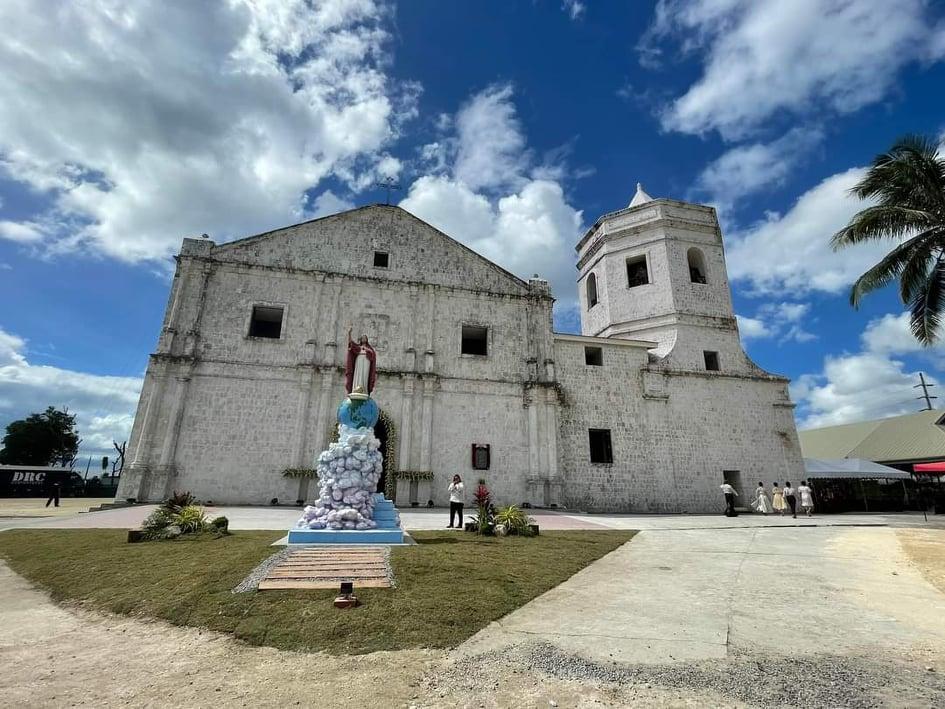Maribojoc church in Bohol reopened to the public

TAGBILARAN CITY - Angelito Antatico was emotional when he attended Mass at the Santa Cruz Parish Church (Holy Cross Parish Church) or popularly known as Maribojoc church on Sunday, Dec. 12.
It was first time that the church was reopened since it was destroyed by the 7.2-magnitude earthquake that jolted Bohol and neighboring provinces on Oct. 15, 2013.
“It's amazing that the reconstruction of our church is finished. We considered it a miracle from God,” said Antatico, a resident of Barangay Lincod of Maribojoc town.
"You'll be amazed with the altar because it seems the same," he continued as referring to the neo-Gothic and Mudejar-styled retablo incorporated with local motifs.
The church stands now as a faithful semblance to the centuries-old church that the temblor levelled to the ground.
The ceiling paintings executed by Cebuano master painter Raymundo Francia was meticulously restored by local artists, guided by expert art restorers and conservators.
On Sunday, the National Museum of the Philippines (NMP), which supervised the reconstruction of the church, turned over the church and its Diocesan Shrine of St. Vincent Ferrer to the Diocese of Tagbilaran, which has ecclesiastical jurisdiction over the town.
The turnover ceremony was attended by Jeremy Barns, Director General of the NMP, Tagbilaran Bishop Alberto Uy, parish priest Fr. Floro Hora, priests, nuns and parishioners.
Also present were local officials headed by Maribojoc Mayor Romulo Manuta, former Maribojoc Mayor Leoncio Evasco, presidential adviser on streamlining of government processes, Gov. Arthur Yap, Rep. Edgar Chatto, project teams, experts, supporters and members of the community.
Archbishop Charles John Brown, the Apostolic Nuncio to the Philippines, was the special guest who also delivered his homily during the Pontifical Mass.
Brown said the event in Maribojoc was called "Gaudete Sunday" which means "Rejoice Sunday."
"This joy is overflowing as we enter this beautiful church. This church represents so wonderfully the cooperation and collaboration of church and state," Brown said.
Also present were Spanish Ambassador Jorge Moragas Sanchez and Bishops Antonieto Cabahug (Surigao), Crispin Varquez (Borongan in Eastern Samar), Julito Cortes (Dumaguete), Leonardo Medroso (Tagbilaran Bishop Emeritus), Arturo Bastes (Sorsogon), Romulo Valles (Archbishop of the Archdiocese of Davao and former president of the Catholic Bishops' Conference of the Philippines) and Patrick Daniel Parcon (Talibon).
Barns said the completion of the Maribojoc church ends rehabilitation and restoration projects of damaged churches and historical landmarks undertaken by NMP in the province.
Eight years since the Bohol earthquake, the NMP has restored the heritage church complexes of Loboc, Dimiao, Alburquerque, Cortes and Panglao; reconstructed the churches of Loon and Maribojoc, as well as the watchtowers in Loay, Panglao and Balilihan.
"As we move forward with our lives, we will be a stronger community across all sectors cherish all the more our landmarks and monuments, faith, heritage and identity. And together we must ensure that they stand for more generations to come as the treasure and pride of all that we want to pass on," Barns said.
Sanchez said he was inspired by the cooperation of leaders and the community, the same event that happened on March 16, 1565 that Datu Sikatuna, a local chieftain of Bohol and Spanish explorer Miguel López de Legazpi sealed their friendship thru Sandugo (blood compact).
Uy said that the rehabilitation of Bohol churches was an incontrovertible proof that the cooperation of the church and state guided by bilateral and mutual agreement does work in Bohol.
"I believe we are opening a new chapter. As in the book we are the authors writing line by line, paragraph after paragraph, page after page, chapter after chapter, but for now today is when our book begins. The rest of the chapter is still unwritten. May God begin his work will carry on to the final completion," Uy said.
The Santa Cruz Church was built by the Recollects in 1886 to replaced the temporary church built by the Jesuits shortly after Maribojoc served as a Jesuit mission in the 18th century.
The convent unlike most churches in Bohol was located behind the church giving it an unobstructed view of the Bohol sea.
The church was a cruciform and its facade plain but its church ceiling was made of metal and painted with catechetical and liturgical motifs and well-preserved until the church was razed to the ground by the 2013 quake.
The Maribojoc church is one of two Spanish colonial period churches- the other church, the Our Lady of Light Parish in Loon, a town adjacent to Maribojoc, had already been turned over to the same diocese last September 7, 2021.
Like other centuries-old churches in Bohol which were devastated by the earthquake, the Maribojoc was made of coral stone.
At least 24 other ancient churches in Bohol were either destroyed or damaged in 2013. Ten were considered national heritage landmarks.
When the earthquake struck, the entire Maribojoc church crumbled to the ground, leaving only the image of the Sacred Heart of Jesus standing in front of the church. The image of the miraculous St. Vincent Ferrer, the second patron saint of the town, was found unscathed considered by the faithful a miracle.
The Maribojoc church has been declared as a National Cultural Treasure on May 5, 2010 by the National Museum in view of its high significance to the culture and history of the Filipino nation, the recovery, protection and conservation of all cultural materials in this site is under the auspices of the National Commission of Culture and the Arts, as cultural heritage resources to be passed on to future generations.
The site, due to its colonial architecture representative of the Spanish colonial period, had also been listed by the National Historical Institute (now National Historical Commission of the Philippines) as a historic center/ heritage zone. -- BAP, GMA News




